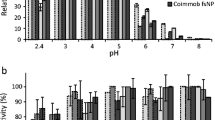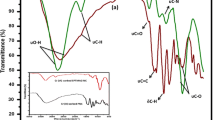Abstract
Municipal landfill leachate (MLL) contamination in surface water is a critical global issue due to the high concentration of toxic organics and recalcitrants. The biological treatment of MLL is ineffective due to an elevated concentration of ammoniacal nitrogen, which restricts the production of the recalcitrant degrading laccase enzyme. In this context, integrating an external laccase-anchored carbon catalyst (LACC) matrix system with the microbial system could be an efficient strategy to overcome the drawbacks of conventional biological MLL treatment technologies. In the present study, the LACC matrix was synthesized by utilizing nanoporous activated carbon (NAC) functionalized ethylene diamine (EDA) and glutaraldehyde (GA) (GA/EDA/NAC) matrix for the anchoring of laccase. The maximum anchoring capacity of laccase onto GA/EDA/NAC was achieved to be 139.65 U/g GA/EDA/NAC at the optimized anchoring time, 60 min; pH, 5; temperature, 30 °C, and mass of GA/EDA/NAC, 300 mg and was confirmed by Fourier transform Infrared Spectroscopy (FT-IR), Scanning Electron Microscope (SEM), and X-ray Diffraction (XRD) analyses. Further, the mechanistic study revealed the involvement of covalent bonding in the anchoring of laccase onto the functionalized surface of the GA/EDA/NAC matrix. The adsorption isotherm and kinetics of laccase anchoring onto the GA/EDA/NAC matrix were performed to evaluate its field-level application. Subsequently, the sequential microbial system (I-stage bacterial treatment followed by II-stage fungal treatment) and III-stage LACC matrix system could effectively reduce the COD by 94.2% and phenol by 92.36%. Furthermore, the Gas Chromatography-Mass Spectrophotometry (GC–MS) and FT-IR analyses confirmed the effective degradation of organic compounds and recalcitrants by the integrated microbial and LACC matrix system. The study suggested that the application of the LACC matrix system has resulted in the complete treatment of real-time MLL by overcoming the negative interference of elevated ammoniacal nitrogen concentration. Thus, the integrated microbial and LACC matrix approach could be considered to effectively treat the MLL without any secondary pollution generation.
Graphical abstract













Similar content being viewed by others
Data availability
The authors confirm that the data supporting the findings of this study are available within the article and its supplementary materials.
References
Narayana T (2009) Municipal solid waste managemexnt in India: From waste disposal to recovery of resources? Waste Manag 29(3):1163–1166. https://doi.org/10.1016/j.wasman.2008.06.038
Hanrahan D, Srivastava S, Sita RA (2006). Improving management of municipal solid waste in India—Overview and challenges. Environment and Social Development Unit, South Asia Region. The World Bank. http://hdl.handle.net/10986/19463
Uddin M et al (2023) The role of wastewater treatment technologies in municipal landfill leachate treatment. Biotechnology for emerging pollutants remediation and energy conversion. Springer Nature Singapore, Singapore. https://doi.org/10.1007/978-981-99-1179-0_7
Ramani et al (2021) Recent advances in understanding the role of wastewater treatment processes for the removal of plastic derived nitrogen compounds in municipal landfill leachate. Soil Recycl Manag Anthropocene Era. https://doi.org/10.1007/978-3-030-51886-8_1
Keyikoglu R et al (2021) A review on treatment of membrane concentrates generated from landfill leachate treatment processes. Sep Purif 259:118182. https://doi.org/10.1016/j.seppur.2020.118182
Karatas et al (2022) Perfluorooctanoic acid (PFOA) removal from real landfill leachate wastewater and simulated soil leachate by electrochemical oxidation process. Environ Technol Innov 28:102954. https://doi.org/10.1016/j.eti.2022.102954
Liu M et al (2021) Accelerated Fe2+ regeneration in an effective electro-fenton process by boosting internal electron transfer to a nitrogen-conjugated Fe (III) complex. Environ Sci Technol 55(9):6042–6051. https://doi.org/10.1021/acs.est.0c08018
Lee J, Von Gunten U, Kim JH (2020) Persulfate-based advanced oxidation: critical assessment of opportunities and roadblocks. Environ Sci Technol 54(6):3064–3081. https://doi.org/10.1021/acs.est.9b07082
Wang X et al (2021) Flow-through heterogeneous electro-Fenton system based on the absorbent cotton derived bulk electrode for refractory organic pollutants treatment. Sep Purif Technol 276:119266. https://doi.org/10.1016/j.seppur.2021.119266
Xiong et al (2018) Mature landfill leachate treatment by the MBBR inoculated with biocarriers from a municipal wastewater treatment plant. Proc Saf Environ Prot 119:304–310. https://doi.org/10.1016/j.psep.2018.08.019
Tsui et al (2020) Food waste leachate treatment using an upflow anaerobic sludge bed (UASB): effect of conductive material dosage under low and high organic loads. Bioresour Technol 304:122738. https://doi.org/10.1016/j.biortech.2020.122738
Wang et al (2018) Treatment of landfill leachate using activated sludge technology: a review. Archaea. https://doi.org/10.1155/2018/1039453
Tałałaj IA, Biedka P, Bartkowska I (2019) Treatment of landfill leachates with biological pretreatments and reverse osmosis. Environ Chem Lett 17(3):1177–1193. https://doi.org/10.1007/s10311-019-00860-6
Somani M et al (2019) Comprehensive assessment of the leachate quality and its pollution potential from six municipal waste dumpsites of India. Bioresource Technol Rep 6:198–206. https://doi.org/10.1016/j.biteb.2019.03.003
Ahmadzadeh S, Dolatabadi M (2018) Modeling and kinetics study of electrochemical peroxidation process for mineralization of bisphenol a; a new paradigm for groundwater treatment. J Mol Liq 254:76–82. https://doi.org/10.1016/j.molliq.2018.01.080
Lindamulla et al (2022) Municipal solid waste landfill leachate characteristics and their treatment options in tropical countries. Curr Pollut Rep 8(3):273–287. https://doi.org/10.1007/s40726-022-00222-x
da Silva PSG et al (2022) Landfill leachate biological treatment: perspective for the aerobic granular sludge technology. Environ Sci Pollut Res 29(30):45150–45170. https://doi.org/10.1007/s11356-022-20451-3
Miao L et al (2019) Recent advances in nitrogen removal from landfill leachate using biological treatments–a review. J Environ Manag 235:178–185. https://doi.org/10.1016/j.jenvman.2019.01.057
Song JY (2020) A pilot-scale study on the treatment of landfill leachate by a composite biological system under low dissolved oxygen conditions: Performance and microbial community. Bioresour Technol 296:122344. https://doi.org/10.1016/j.biortech.2019.122344
Golwala H et al (2022) Advancement and challenges in municipal landfill leachate treatment–the path forward! ACS ES&T Water 2(8):1289–1300. https://doi.org/10.1021/acsestwater.2c00216
Bhardwaj P et al (2022) Laccase-assisted degradation of emerging recalcitrant compounds-a review. Bioresour Technol. https://doi.org/10.1016/j.biortech.2022.128031
Pounsamy M et al (2019) A novel protease-immobilized carbon catalyst for the effective fragmentation of proteins in high-TDS wastewater generated in tanneries: spectral and electrochemical studies. Environ Res 172:408–419. https://doi.org/10.1016/j.envres.2019.01.062
Ali NS et al (2023) A high throughput screening process and quick isolation of novel lignin-degrading microbes from large number of natural biomasses. Biotechnol Rep 39:e00809. https://doi.org/10.1016/j.btre.2023.e00809
Kim YK, Park SK, Do KS (2003) Treatment of landfill leachate by white rot fungus in combination with zeolite filters. J Environ Sci Heal - A Tox Hazard Subst Environ Eng 38(4):671–683. https://doi.org/10.1081/ESE-120016932
Tien M, Kirk TK (1988) Lignin peroxidase of Phanerochaete chrysosporium. Methods Enzymol 161:238–249. https://doi.org/10.1016/0076-6879(88)61025-1
Ramani K et al (2010) Immobilization of acidic lipase derived from Pseudomonas gessardii onto mesoporous activated carbon for the hydrolysis of olive oil. J Mol Catal B Enzym 62:58–65. https://doi.org/10.1016/j.molcatb.2009.09.004
Ramani K et al (2012) Surface functionalized mesoporous activated carbon for the immobilization of acidic lipase and their application to hydrolysis of waste cooked oil: isotherm and kinetic studies. Process Biochem 47(3):435–445. https://doi.org/10.1016/j.procbio.2011.11.025
Uddin M et al (2021) Biosequestration of lignin in municipal landfill leachate by tailored cationic lipoprotein biosurfactant through Bacillus tropicus valorized tannery solid waste. J Environ Manag 300:113755. https://doi.org/10.1016/j.jenvman.2021.113755
Suganthi H, Kandasamy R (2017) A novel single step synthesis and surface functionalization of iron oxide magnetic nanoparticles and thereof for the copper removal from pigment industry effluent. Sep Purif Technol 188:458–467. https://doi.org/10.1016/j.seppur.2017.07.059
Ozcan S, Tor A, Aydin ME (2010) Determination of polycyclic aromatic hydrocarbons in waters by ultrasound-assisted emulsification-microextraction and gas chromatography-mass spectrometry. Anal Chim Acta 665(2):193–199. https://doi.org/10.1016/j.aca.2010.03.047
Bajwa PK, Arora DS (2009) Comparative production of ligninolytic enzymes by Phanerochaete chrysosporium and Polyporus sanguineus. Can J Microbiol 55:1397–1402. https://doi.org/10.1139/W09-094
Smaoui Y et al (2018) A new approach for detoxification of landfill leachate using Trametes trogii. Environ Eng Res 24(1):144–149. https://doi.org/10.4491/eer.2018.014
Pounsamy M et al (2019) Removal of fat components in high TDS leather wastewater by saline-tolerant lipase-assisted nanoporous-activated carbon. Appl Biochem Biotechnol 187:474–492. https://doi.org/10.1007/s12010-018-2833-0
Saranya P, Ranjitha S, Sekaran G (2015) Immobilization of thermotolerant intracellular enzymes on functionalized nanoporous activated carbon and application to degradation of an endocrine disruptor: kinetics, isotherm and thermodynamics studies. RSC Adv 5(81):66239–66259. https://doi.org/10.1039/C5RA11279F
Reid ID (1979) The influence of nutrient balance on lignin degradation by the white-rot fungus Phanerochaete chrysosporium. Canad J Bot 57(19):2050–2058. https://doi.org/10.1139/b79-255
Lofrano G et al (2013) Chemical and biological treatment technologies for leather tannery chemicals and wastewaters: a review. Sci Total Environ 461:265–328. https://doi.org/10.1016/j.scitotenv.2013.05.004
Mannacharaju M, Somasundaram S, Ganesan S (2020) Treatment of post tanning wastewater with minimum sludge generation using sequential anoxic/oxic bioreactor and its microbial community profile. J Water Process Eng 35:101244. https://doi.org/10.1016/j.jwpe.2020.101244
de Castro TMT et al (2019) Anaerobic co-digestion of industrial landfill leachate and glycerin: methanogenic potential, organic matter removal and process optimization. Environ Technol 41:2583–2593. https://doi.org/10.1080/09593330.2019.1575915
Amaral MC et al (2017) Performance evaluation of startup for a yeast membrane bioreactor (MBRy) treating landfill leachate. J Environ Sci Health A 52:1352–1360. https://doi.org/10.1080/10934529.2017.1357407
Maheepala SS et al (2022) Stable denitrification performance of a mesh rotating biological reactor treating municipal wastewater. Environ Technol Innov 27:102543. https://doi.org/10.1016/j.eti.2022.102543
Xiong J et al (2018) Mature landfill leachate treatment by the MBBR inoculated with biocarriers from a municipal wastewater treatment plant. Process Saf Environ Prot 119:304–310. https://doi.org/10.1016/j.psep.2018.08.019
Paskuliakova A et al (2016) Phycoremediation of landfill leachate with chlorophytes: phosphate a limiting factor on ammonia nitrogen removal. Water Res 99:180–187. https://doi.org/10.1016/j.watres.2016.04.029
Dan NH, Le Luu T (2021) High organic removal of landfill leachate using a continuous flow sequencing batch biofilm reactor (CF-SBBR) with different biocarriers. Sci Total Environ 787:147680. https://doi.org/10.1016/j.scitotenv.2021.147680
Duyar A et al (2021) Treatment of landfill leachate using single-stage anoxic moving bed biofilm reactor and aerobic membrane reactor. Sci Total Environ 776:145919. https://doi.org/10.1016/j.scitotenv.2021.145919
Zhu Z et al (2021) Efficient treatment of mature landfill leachate with a novel composite biological trickle reactor developed using refractory domestic waste and aged refuse. J Clean Prod 305:127194. https://doi.org/10.1016/j.jclepro.2021.127194
Luo H et al (2020) Recent advances in municipal landfill leachate: a review focusing on its characteristics, treatment, and toxicity assessment. Sci Total Environ 703:135468. https://doi.org/10.1016/j.scitotenv.2019.135468
Acknowledgements
Maseed Uddin acknowledge the Department of Science and Technology, Ministry of Science and Technology, Government of India for providing the INSPIRE fellowship [DST/INSPIRE Fellowship/2019/IF190897] to carry out the research. Ramani Kandasamy. sincerely thank the Department of Science and Technology, Ministry of Science and Technology, New Delhi, for funding the project under the Scheme "Scheme for Young Scientists and Technologists (SYST)-Science for Equity and Empowerment Division (SEED)”; Project No: SP/YO/2019/1360(G).
Funding
Department of Science and Technology, Ministry of Science and Technology, Government of India, DST/INSPIRE Fellowship/2019/IF190897, Maseed Uddin, SP/YO/2019/1360(G), Ramani K.
Author information
Authors and Affiliations
Corresponding author
Ethics declarations
Conflict of interest
The authors declare that they have no competing financial interests or personal relationships that could have appeared to influence the work reported in this paper.
Additional information
Publisher's Note
Springer Nature remains neutral with regard to jurisdictional claims in published maps and institutional affiliations.
Supplementary Information
Below is the link to the electronic supplementary material.
Rights and permissions
Springer Nature or its licensor (e.g. a society or other partner) holds exclusive rights to this article under a publishing agreement with the author(s) or other rightsholder(s); author self-archiving of the accepted manuscript version of this article is solely governed by the terms of such publishing agreement and applicable law.
About this article
Cite this article
Uddin, M., Sriram, S.S., Krishna, K. et al. A novel integrated microbial and laccase-anchored carbon catalyst system for the effective treatment of toxic organic and recalcitrant-rich municipal landfill leachate. Carbon Lett. (2024). https://doi.org/10.1007/s42823-024-00706-4
Received:
Revised:
Accepted:
Published:
DOI: https://doi.org/10.1007/s42823-024-00706-4




